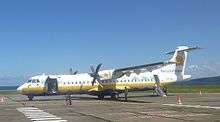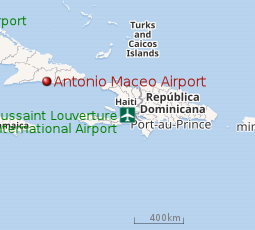Aero Caribbean Flight 883
Aero Caribbean Flight 883 was a domestic scheduled passenger service from Port-au-Prince, Haiti to Havana, Cuba with a stopover in Santiago de Cuba. On 4 November 2010, the ATR 72 operating the route crashed in the central Cuban province of Sancti Spíritus, killing all 61 passengers and 7 crew members aboard.[1]
 CU-T1549, the aircraft involved, at Baracoa Airport one month before the crash | |
| Accident | |
|---|---|
| Date | 4 November 2010 |
| Summary | Crashed following loss of control in icing conditions |
| Site | Near Guasimal, Sancti Spíritus, Cuba 21°44′39″N 79°28′16″W |
| Aircraft | |
| Aircraft type | ATR 72-212 |
| Operator | Aero Caribbean |
| IATA flight No. | 7L883 |
| ICAO flight No. | CRN883 |
| Call sign | AEROCARIBBEAN 883 |
| Registration | CU-T1549 |
| Flight origin | Toussaint Louverture International Airport, Port-au-Prince, Haiti |
| Stopover | Antonio Maceo Airport, Santiago de Cuba, Cuba |
| Destination | José Martí International Airport, Havana, Cuba |
| Occupants | 68 |
| Passengers | 61 |
| Crew | 7 |
| Fatalities | 68 |
| Survivors | 0 |
 |
Accident
The aircraft departed Santiago de Cuba en route to Havana around 16:50 local time (20:50 UTC).[2] It was the last flight out of Santiago de Cuba airport before it was closed because of the approach of Hurricane Tomas.[3] At 17:42, the aircraft crashed near the village of Guasimal in Sancti Spíritus province, some 210 miles (340 km) southeast of Havana, after issuing a distress call.[2] Witnesses said the plane was "flying low and appeared unstable ... pouring out smoke and fire", before hearing an explosion.[4]
Medical facilities in Guasimal were put on alert to prepare for emergency patients. However, by midnight they were told to stand down as no survivors were expected.[4]
Aircraft
The aircraft involved was a twin-turboprop ATR 72-212 with Cuban registration CU-T1549,[5] in use with Cuba-based Aero Caribbean since October 2006.[4] It was delivered from the production line in 1995 to its first owner, Simmons Airlines and also with Continental Express as the second one.[6] According to the manufacturer, the plane had accumulated almost 25,000 flight hours in more than 34,500 flights.[4] Aero Caribbean is wholly owned by the government of Cuba.[7]
Passengers and crew
The passengers and crew were of various nationalities.
| Nationality | Passengers | Crew | Total |
|---|---|---|---|
| Cuba | 33[4] | 7[4] | 40 |
| Argentina | 10[8] | – | 10 |
| Mexico | 7[9] | – | 7 |
| Netherlands | 3[10] | – | 3 |
| Australia | 2[11] | – | 2 |
| France | 1[12] | – | 1 |
| Germany | 1[8] | – | 1 |
| Italy | 1[12] | – | 1 |
| Japan | 1[1] | – | 1 |
| Spain | 1[12] | – | 1 |
| Venezuela | 1[12] | – | 1 |
| Total | 61 | 7 | 68 |
Search and recovery
In order to allow access to the crash site, rescue workers had to use bulldozers to plow through thick vegetation.[13] The aircraft was completely destroyed by the impact and resulting explosion, and all the victims' bodies were badly burned.[14] Investigators believe that the passengers had no time to react because all bodies were found in their own seats, which helped investigators with identifications.[15] The wreckage burned for hours after the crash.[16] The recovered bodies were to be sent to Cuba's Institute of Legal Medicine for identification.[4]
The day after the crash, on 5 November, rescue workers recovered the flight data and cockpit voice recorders. They were turned over to investigators for inspection and analysis.[4]
Reactions
Argentine President Cristina Fernández de Kirchner sent a plane with relatives of the victims to bring home the bodies.[4] Spanish Prime Minister José Luis Rodríguez Zapatero,[4] South African President Jacob Zuma,[17] Polish President Bronisław Komorowski[18] and French Foreign Minister Bernard Kouchner, in a message addressing Cuban Foreign Affairs Minister Eduardo Rodriguez Parrilla,[19] all sent condolences.
Investigation
The Instituto de Aeronáutica Civil de Cuba (IACC) investigated the accident with assistance from aircraft manufacturer ATR and the French Bureau d'Enquêtes et d'Analyses pour la Sécurité de l'Aviation Civile (BEA).[20][21]
In December 2010, the IACC stated that the analysis of the flight recorders did not highlight any technical problem with the ATR 72. The airplane encountered severe icing conditions at 20,000 ft, which were not handled properly, leading to the crash.[3]
References
- "Passenger plane crashes in Cuba". BBC News. 5 November 2010. Archived from the original on 5 November 2010. Retrieved 5 November 2010.
- "Plane With 68 Said to Crash in Cuba". The New York Times. Retrieved 5 November 2010.
- Hradecky, Simon. "Crash: Aerocaribbean AT72 near Guasimal on Nov 4th 2010, impacted ground after emergency call". The Aviation Herald. Retrieved 5 November 2010.
- "Plane with 68 said to have crashed in Cuba". Reuters. 5 November 2010. Archived from the original on 8 November 2010. Retrieved 5 November 2010.
- "Accident description". Aviation Safety Network. Archived from the original on 8 November 2010. Retrieved 5 November 2010.
- "Aero Caribbean CU-T1549 (ATR 42/72 – MSN 459) (Ex EC-HBU N12903 ) | Airfleets aviation". Airfleets.net. Archived from the original on 9 November 2010. Retrieved 6 November 2010.
- Flight International 27 March 2007
- "Quiénes son los fallecidos argentinos en el accidente" [Who are the Argentine deceased in the accident]. La Nación (in Spanish). Archived from the original on 7 November 2010. Retrieved 6 November 2010.
- Пассажирами разбившегося на Кубе самолета были граждане 11 стран [Passengers of the plane crashed in Cuba were citizens of 11 countries] (in Russian). Lenta. Archived from the original on 6 November 2010. Retrieved 5 November 2010.
- "3 Nederlanders dood bij crash Cuba" [3 Dutchmen killed in Cuba crash] (in Dutch). Nederlandse Omroep Stichting. Archived from the original on 8 November 2010. Retrieved 5 November 2010.
- Australians killed in Cuba plane crash Australian Broadcasting Corporation – (6 November 2010 ) – Retrieved 6 November 2010
- "Relación de fallecidos en el accidente de la aeronave ATR-72-212" [List of deaths in the accident of the aircraft ATR-72-212] (in Spanish). Juventud Revelde. Archived from the original on 9 November 2010. Retrieved 5 November 2010.
- "Rescuers pulling bodies from Cuba plane crash". The Sun Daily. Retrieved 8 November 2010.
- "Rescuers find black box of crashed Cuban plane". The Gazette. Montreal. Archived from the original on 9 November 2010. Retrieved 8 November 2010.
- "Rescue workers remove bodies from Cuba plane crash". Associated Press. Archived from the original on 9 November 2010. Retrieved 8 November 2010.
- Malkin, Elisabeth (5 November 2010). "Cuban Plane Crash Kills 68 People". The New York Times. Archived from the original on 21 November 2013. Retrieved 6 November 2010.
- "Zuma condoles Cuba after plan crash Archived 16 July 2011 at the Wayback Machine." BuaNews. 5 November, 2010. Retrieved on 5 November, 2010.
- "Kondolencje po katastrofie kubańskiego samolotu" (in Polish). Office of the President of Poland. Archived from the original on 28 September 2011. Retrieved 7 November 2010.
- France sends condolences to Cuba over fatal air crash. 6 Nov.. 2010. People's Daily.
- "ATR statement on Aero Caribbean Flight 883". ATR. Retrieved 5 November 2010.
- "Flight 883 on 4 November 2010 ATR 72–212, registered CU-T1549". Bureau d'Enquêtes et d'Analyses pour la Sécurité de l'Aviation Civile. Archived from the original on 21 July 2011. Retrieved 5 November 2010.